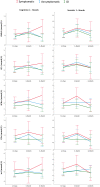Longitudinal changes in brain metabolites following pediatric concussion
- PMID: 38331924
- PMCID: PMC10853495
- DOI: 10.1038/s41598-024-52744-7
Longitudinal changes in brain metabolites following pediatric concussion
Abstract
Concussion is commonly characterized by a cascade of neurometabolic changes following injury. Magnetic Resonance Spectroscopy (MRS) can be used to quantify neurometabolites non-invasively. Longitudinal changes in neurometabolites have rarely been studied in pediatric concussion, and fewer studies consider symptoms. This study examines longitudinal changes of neurometabolites in pediatric concussion and associations between neurometabolites and symptom burden. Participants who presented with concussion or orthopedic injury (OI, comparison group) were recruited. The first timepoint for MRS data collection was at a mean of 12 days post-injury (n = 545). Participants were then randomized to 3 (n = 243) or 6 (n = 215) months for MRS follow-up. Parents completed symptom questionnaires to quantify somatic and cognitive symptoms at multiple timepoints following injury. There were no significant changes in neurometabolites over time in the concussion group and neurometabolite trajectories did not differ between asymptomatic concussion, symptomatic concussion, and OI groups. Cross-sectionally, Choline was significantly lower in those with persistent somatic symptoms compared to OI controls at 3 months post-injury. Lower Choline was also significantly associated with higher somatic symptoms. Although overall neurometabolites do not change over time, choline differences that appear at 3 months and is related to somatic symptoms.
© 2024. The Author(s).
Conflict of interest statement
The authors declare no competing interests.
Figures






References
-
- Faul, M., Xu, L., Wald, M. M. & Coronado, V. G. Traumatic Brain Injury in the United States: Emergency department visits, hospitalizations and deaths 2002–2006. Centers Dis. Control Prev. Natl. Cent. Inj. Prev. Control (2010).
Publication types
MeSH terms
Substances
Grants and funding
LinkOut - more resources
Full Text Sources
Medical

